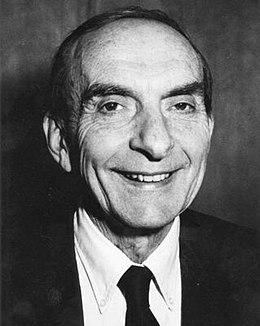Loading AI tools
American theoretical physicist From Wikipedia, the free encyclopedia
Gerald Edward Brown (also known as Gerry Brown, July 22, 1926 - May 31, 2013)[1] was an American theoretical physicist who worked on nuclear physics and astrophysics. Since 1968 he had been a professor at the Stony Brook University.[2] He was a distinguished professor emeritus of the C. N. Yang Institute for Theoretical Physics at Stony Brook University.
Gerald Edward Brown | |
|---|---|
 | |
| Born | July 22, 1926 |
| Died | May 31, 2013 (aged 86) New York City, US |
| Alma mater | University of Wisconsin Yale University University of Birmingham |
| Known for | Elucidating the effects of various nuclear constituents on nucleon interactions and nucleon structure |
| Awards | Hans Bethe Prize Tom W. Bonner Prize in Nuclear Physics Max Planck Medal |
| Scientific career | |
| Fields | Quantum mechanics, Nuclear Physics |
| Institutions | Stony Brook University NORDITA Princeton University |
| Theses | |
| Doctoral advisors | Gregory Breit (at Yale) Rudolf Peierls (at Birmingham) |
| Doctoral students | Elliott H. Lieb Che-Ming Ko Ulf-G. Meißner Kevin S. Bedell |
| Website | tonic |
Brown received his bachelor's degree in physics in 1946 from the University of Wisconsin and in 1948 his master's degree from Yale University, where in 1950 he earned his PhD (under Gregory Breit). In 1957 he earned his D.Sc. from the University of Birmingham in England (under Rudolf Peierls), where he was from 1955 docent and in 1959/60 was professor for theoretical physics. From 1960 to 1985 he was a professor at NORDITA in Copenhagen and concurrently from 1964 to 1968 Professor at Princeton and since 1968 he was a professor at the State University of New York at Stony Brook, where he became Distinguished Professor of Physics in 1988.[2]
Brown worked first in theoretical atomic physics (self-ionization of the vacuum with Geoff Ravenhall in 1951, Lamb shift in heavy atoms, electron-electron interactions, precise calculation of Rayleigh scattering). In nuclear physics, where he was for decades one of the leading theorists of nuclear many body problems in particle physics, he worked, for example, with Mark Bolsteri on the giant dipole resonance, with Tom Kuo on effective interactions of nucleons in atomic nuclei, as well on chiral invariant theories of the atomic nucleus (with Mannque Rho and Dan-Olof Riska), that is to say, field theories with pions and other mesons. Starting in the 1970s he worked frequently in collaboration with Hans Bethe on the nuclear-physics-derived equations of state in the theory of compact stars (gravitational collapse, supernovae, double stars with compact stars as partners, development of black holes, gamma ray bursts). Since the end of the 1970s, Brown worked on bag models of nucleons (Chiral bag model).[3] In the 1980s he also worked together with K. Bedell on Fermi liquid theory. Toward the end of Bethe's life, Bethe told Brown to explain his work to the rest of the world.
Brown received an honorary doctorate from the Helsinki (1982), Birmingham (1990) and Copenhagen (1998).[2]
Seamless Wikipedia browsing. On steroids.
Every time you click a link to Wikipedia, Wiktionary or Wikiquote in your browser's search results, it will show the modern Wikiwand interface.
Wikiwand extension is a five stars, simple, with minimum permission required to keep your browsing private, safe and transparent.